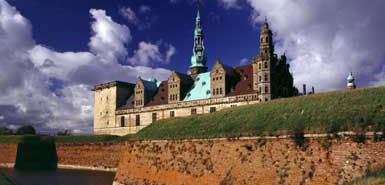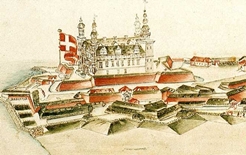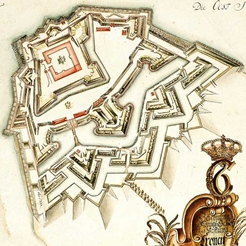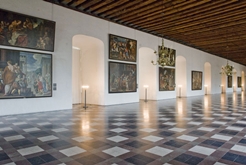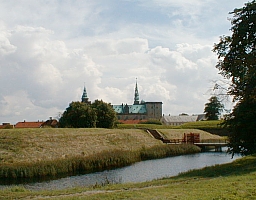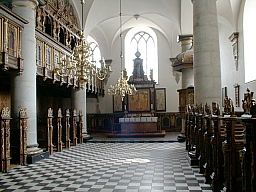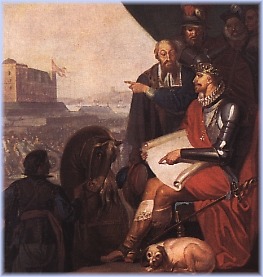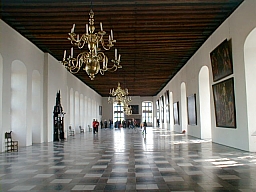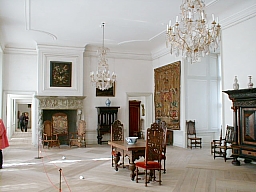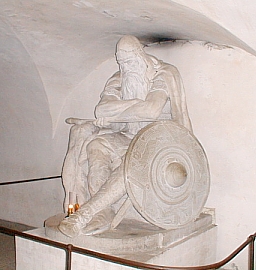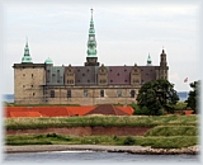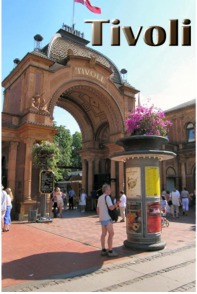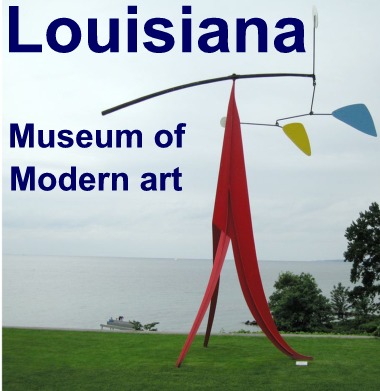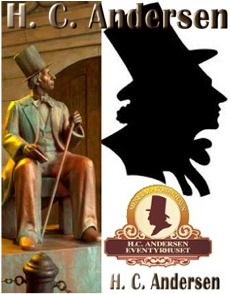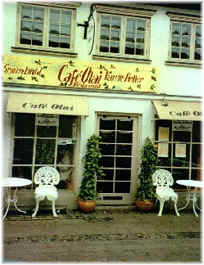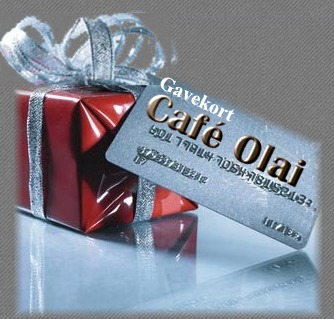Visit Kronborg Castle or Hamlets Castle, immortalised by Wiliam Shakespeare, situated at Helsingør or Elsinore and built by King Frederik II of Denmark in 1590. and Holder Danske are watching - The Danish tourist attraction - Tourist Attractions in North Sealand Denmark |
|||||||||||
|
|
|||||||||||
|
Welcome to Kronborg
Castle- Hamlets Castle Elsinore
|
|||||||||||
|
Visit Elsinore tour Excursions map PDF What's in Elsinore and the surrounding area Read much more about ART and Culture in North Sealand Denmark Read much more about Hamlet the play by William Shakespeare Hamlets Castle / Kronborg Castle in Elsinore, at the seaward approach to The Sound Øresund, is one of northern Europe's most important Renaissance castles. Known all over the world from Shakespeare 's play Hamlet, it is also the most famous castle in Denmark and the Danish tourist attraction is visited each year by about 200,000 tourists. King Frederik II's Kronborg Castle Elsinore is both an elegant Renaissance castle and a monumental military fortress surrounded by major fortifications with bastions and ravelins and a great Danish tourist attraction. Some of the historical rooms house collections of Renaissance and Baroque interiors, and among the most important attractions are the 62-metre long ballroom, the wonderfully preserved chapel and the statue of " Holger the Dane ". Development of Kronborg Castle Hamlets Castle Elsinore
|
|||||||||||
|
Kronborg Castle Elsinore - Hamlets Castle and Danish tourist attraction |
|||||||||||
|
|||||||||||
Hamlet and Kronborg Castle ElsinoreThe legend’s association with Elsinore and Kronborg did not begin until Shakespeare, presumably due to Elsinore’s status as one of the world’s most important towns in the 1600s. Thanks to the Sound Dues which was a special toll that all passing ships had to pay in the town, Elsinore had become a traffic hub for international shipping. The town was also regarded as a cultural centre due to the newly built royal castle, Kronborg. It is unknown whether Shakespeare actually ever visited Elsinore. It is known with certainty, however, that a number of English and Scots players from his retinue performed as visiting actors at Kronborg and in the town of Elsinore. They could have been the source of stories about the illustrious castle on the Sound that reached Shakespeare and which inspired him to set the play here. |
|||||||||||
| “Hamlet” is one of the most famous and frequently performed stage plays in the world. Since the 1600s, countless theatrical productions at the castle and many other venues have endeavoured to keep the legend of Hamlet alive. That is why Kronborg is now known all over the world as Hamlet’s castle, and Elsinore is known as the Town of Hamlet. | |||||||||||
| Hamlet 's Castle this summer 2010 | |||||||||||
| It will be one of the world's largest theaters, Schaubühne Berlin guests Kronborg castle courtyard. | |||||||||||
|
If you think you've seen Hamlet - think
again, Australian Stage - A total wild production, Der Tagesspiegel, a
coup - The Sydney Morning Herald.
To read the fantastic reviews in the international press when it comes to Schaubüne Berlin setup of Hamlet, which toured worldwide. This summer comes the idea to play Hamlet on stage in Kronborg Castle From 17th to 22 August, Hamlet scene Lars Roman Engel has chosen this unique setup as summer performance at Kronborg Castle and the audience might begin to rejoice.
|
|||||||||||
|
It will be one of the world's largest theaters, Schaubühne Berlin guests Kronborg castle courtyard. The acclaimed director Thomas Ostermeier has created a superb production at every level, from idea to execution. The bold new interpretation of Marius Von Mayenburg and the use of expressions from everyday life has created a rebirth of a classic. The crew consists of six star actors who play all roles. They make it agile and competent with endless surprises. Thomas Ostermeier presenting a rebellious and dynamic Hamlet, who is fighting for his right not to fight. Familiar scenes are unexpected or new meaning. Music and video is an important factor in the show and the actors argue pop songs with great professionalism. Tickets can be purchased at: www.billetten.dk or Phone 7020 2096
|
 |
||||||||||
|
Sightseeing
North Sealand - Historic Places - Elsinore
|
|||||||||||
|
One day trip to Kronborg Castle Elsinore - Karen Blixen Museum and Louisiana and great Danish tourist attractions |
|||||||||||
|
|||||||||||
|
|
|||||||||||
| DID
YOU KNOW? The historic Elsinore Theater in Oregon Elsinore received its name from Shakespeare’s immortal tragedy, Hamlet. The design is based on the historic Elsinore Castle in Denmark which is believed to be the setting William Shakespeare chose for Hamlet. |
 Read
abour Elsinore Elsinore Theatre Oregon Read
abour Elsinore Elsinore Theatre Oregon |
||||||||||
|
A brief history of Kronborg
Visit
Elsinore Kronborg Castle was named after King Frederik II in 1577, but its history goes right back to the 1420s, when Erik of Pomerania built the strongly fortified castle known as "Krogen" ("The Hook"). From here the king’s men controlled the shipping in the Sound and collected the unpopular Sound Dues. Frederik II's Kronborg In the years 1574 to 1585 Frederik II carried out the crucial renovation of the site. Over the outdated castle he built a magnificent Renaissance castle with towers and a spire, adorning it with columns and sculptures. He was influenced by the European princes, for whom wealth rather than military might had become the symbol of power. Kronborg burns down But Kronborg was to experience several dramatic events. On the night of 25 September 1629 the castle was ravaged by fire and only the chapel survived. Christian IV rebuilt the castle, carrying out modernisations and extensive new decorations in the Baroque style. In September 1658 Kronborg was shelled and captured by the Swedes, who took many valuable art treasures as spoils, including a fantastic ornamental fountain from Frederik II's time. The Crownwork In the years that followed, work was carried out on the outer fortifications, and in 1690 Christian V built the Crownwork as an advanced defence against a land attack. From this time on the castle was not generally used as a residence by the royal family, and in 1785 the army converted it into barracks. A number of rooms were rebuilt, but after the army left the castle in 1923, it was thoroughly renovated and restored to how it had been in the days of Frederik II and Christian IV. |
|||||||||||
| The medieval fortress of Krogen
In the 1420s, Erik of Pomerania, King of Denmark, built a castle on Ørekrog - a tongue of land jutting out into the water across from Helsingborg at the narrowest point of the Sound just north of Elsinore. It was no coincidence that the castle was built at this location. The King had just introduced a customs duty to be imposed on all foreign ships passing through the Sound. The ”Sound Dues” would be of great importance for the King and for Denmark's economy for more than 400 years and were not abolished until 1857 on the initiative of America. The castle was named after the place and called 'Krogen' ('The Hook'). Surrounded by a very thick ring wall and with an 80 x 80 m ground plan, the castle was very large by the standards of that time. Within the ring wall were three corner houses of stone: In the north-eastern corner the King's residence, in the south-eastern corner a combined brew-house and kitchen that may also have served as a chapel, and in the south-western corner a vaulted banquet hall. Approx. 70 per cent of these stone houses are part of the modern-day Kronborg Castle. |
|||||||||||
| The Renaissance Castle of
Kronborg
While Krogen was a strong castle, due to the emergence of new attack techniques it became obsolete as a fortress by the mid-1500s, and as a royal residence it did not meet the standards of the Renaissance period. The fact that Frederik II had married his young cousin Sofie of Mecklenburg in 1572 only increased the need for a residence more consistent with their position, as she was the daughter of wealthy duke and used to having the best of everything. The King was not lacking in inspiration for a new castle as he had seen several examples of princely Renaissance residences on his travels around Europe. Frederik II started modernising the medieval castle in 1574, and the first step was to reinforce the outer defences. Under the management of Hans van Paeschen, the fortress architect, corner bastions were constructed and connected by tall ramparts, and moats were established to the south and west. A huge square cannon tower was erected in the south-western corner, perhaps even at an earlier time, to make it possible to fire on the land side. In 1577, the reinforcement of the fortress was completed, and Hans van Paeschen resigned. Concurrently with the reinforcement of the fortress, the residence was modernised. The King's house to the north was extended and a storey was added. Apartments were fitted up for both the King and the Queen. The wings of the castle to the west and south were also heightened and connected. Rather than following an overall plan, this was more likely the result of a gradually increasing level of ambition. After van Paeschen another Dutch master builder, Anthonis van Opbergen, was engaged to be in charge of the construction work. The buildings were in red brick with grey sandstone decorations after a Dutch pattern until 1580 when the King decided to face the castle with sandstone - possibly due to its exposed location by the water or to distinguish the King's residence from the manor houses of the nobility. |
|||||||||||
| Kronborg completed
In 1585, Kronborg was completed as a well-proportioned four-wing building that was three storeys high and faced with greyish-yellow sandstone. With oriel towers on the outer corners, octagonal stair turrets facing the courtyard, columned portals, and copper roofs with attics and imaginative gables. In the middle of the courtyard there was a magnificent fountain with water-spouting bronze figures surrounding the sea god Neptune. Kronborg had become a mighty Renaissance castle unequalled in Northern Europe and a residence worthy of the King and Queen of Denmark. The chapel in the south wing was converted into a castle chapel. Above the chapel on the third floor, a great hall extended throughout the length of the wing. This hall, called the Ballroom, was lavishly decorated with a series of 40 tapestries portraying the Danish kings. The tapestries were finished in 1584, and the absolute culmination of the decorative scheme was produced from 1585 to 1586: the Royal Couple's table canopy with its backpiece of Flemish wool and purple gold and silver-wrought silk and with an allegoric decoration emphasising the status of the King of the Sound. Fourteen of the 40 King's Tapestries have survived, seven of which are kept at Kronborg and seven at the National Museum in Copenhagen. The table canopy was removed by the Swedes as spoils of war in 1658 and is now exhibited at the National Museum in Stockholm. It was temporarily returned to Kronborg in 2006 as part of the celebration of the Renaissance Year in Denmark. |
|||||||||||
| Christian IV's Kronborg
On the night between 24 and 25 September 1629, Kronborg was destroyed by fire. The walls remained, while large parts of the castle's interior perished. The chapel was saved because the vaulted ceiling was strong enough to withstand the falling, burning beams. Christian IV the king of Denmark wanted to rebuild his father's castle immediately and his argument that once a country no longer appreciates its own architectural treasures it is really impoverished persuaded a reluctant National Council. The Sound Dues were increased, and reconstruction was commenced in 1631 under the management of the King's master builder, Hans van Steenwinckel the Younger. Six years later rebuilding of the castle was completed. Kronborg's exterior was reverently recreated in accordance with his father's castle; Christian IV only made the towers taller. The stair turrets, which used to have spires, only got a dome-shaped copper roof, while the distinguished towers were extended above the roof and fitted with multi-storey spires. The King took the opportunity to modernise the castle's interior. The floor-to-ceiling height of the Ballroom was increased by a couple of metres, and the original coffered ceiling replaced by a series of ceiling paintings with Danish historical motifs. The series was commissioned from Dutch artists from Utrecht, notably Gerrit van Honthorst and Salomon Koninck. A good many of these paintings have survived at the castle. Combined with the replacement of fireplaces and various ornaments, they reflected the introduction of early Baroque at Kronborg. |
|||||||||||
| The more recent history of the
castle
The Dano-Swedish wars in 1657-60 were very hard on Kronborg, which was bombarded and captured in September 1658. When the Swedes left the castle, they took a number of the ceiling paintings from the Ballroom, the fountain in the courtyard as well as the table canopy back to Sweden as spoils of war. The outer fortifications were reinforced with a crownwork in the late 1600s. The interior of the north wing was renovated for Frederik V in 1760-63, but eventually the castle was no longer used as a royal residence. The military moved in, and Kronborg served as a barracks until 1924. Over a period of years up to 1935 the Renaissance castle was then restored under the management of J. Magdahl Nielsen, Royal Inspector of Listed State Buildings. Since that time the castle has been an exhibition site and a tourist destination. Kronborg Castle was inscribed on UNESCO's List of World Heritage Sites in 2000. |
|||||||||||
- Hotels in Copenhagen
- Hotels in Gilleleje
- Hotels in Hornbaek
- Hotel Booking Elsinore
- Hotel Booking Hilleroed
- Kronborg Castle Elsinore

- Kronborg Slot Helsingør

- Visit Elsinore

- Visit Helsingør

- Frederiksborg Castle Hilleroed

- Frederiksborg Slot Hillerød

- Fredensborg royal palace

- Fredensborg Slot Fredensborg

- Hans Christian Andersen Museum Copenhagen

- Handels og Søfartsmuseet Kronborg

- Flynderupgård Museet Espergærde

- LOUISIANA Humlebæk

- Louisiana Museum of Modern Art

- Seværdigheder og natur i Kongernes Nordsjælland

- Experience Shakespeare's Hamlet played at Kronborg castle courtyard

- Read about William Shakespeare at Kronborg Castle

- Besøg Kongernes Nordsjælland




